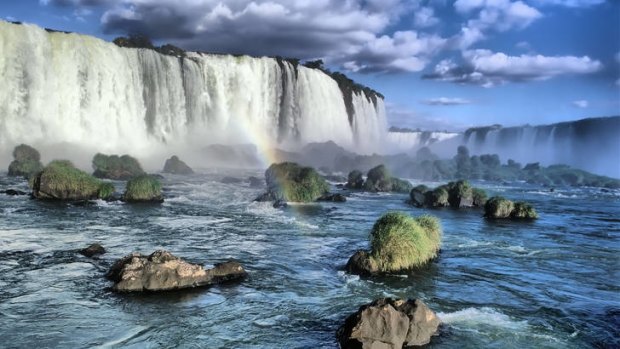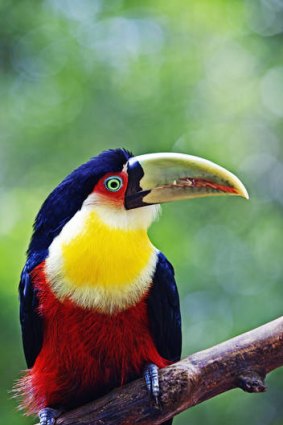By Colin Cosier
Colin Cosier explores one of the world's most spectacular series of waterfalls at the border of several countries.
Tupi-Guarani Indian folklore has it that the Iguazu Falls were created when a serpent god smashed the Iguazu River in a fit of rage to prevent a pair of lovers from escaping in a canoe. The girl was meant to be the snake's virgin offering. The name Iguazu (pronounced eee-gwa-soo) is derived from the Guarani words for "big water". Straddling the border between Brazil and Argentina, the falls are among the world's greatest. Though my girlfriend and I have just two days free to explore, we decide to visit the waterfalls of three countries. It's not as tricky as it might sound, for the watery borders of Brazil, Argentina and Paraguay meet not far from Iguazu. The area is as famous for its reputation as a smugglers' paradise as it is for big water.
Day 1

Border flow ... Iguazu Falls viewed from Brazil.Credit: Alamy
We arrive at Foz do Iguazu International Airport at noon after a quick flight from Brazil's Rio de Janeiro and take a taxi to the Hotel das Cataratas (stopping to buy Iguazu National Park entry tickets on the way; let your taxi driver buy your tickets or risk waiting an hour). The hotel is an elegant, colonial-style building nestled in the national park. It's also the only hotel on the Brazilian side of the park, so unless you stay there, you have to leave the park by 6pm.
The Iguazu Falls are a group of drops and cataracts, the number of which fluctuates depending on the flow of water. Generally, however, there are about 275 waterfalls, most of them on the Argentinian side of the border, which means they're best viewed and photographed from the Brazilian side.
The hotel is a quick stroll from the start of a one-kilometre boardwalk trail that winds along the Iguazu River towards the largest falls. Many of the smaller waterfalls are attractions in their own right but at Iguazu it's the sum of the parts that makes it spectacular. The boardwalk takes you under jungle canopy and up the Iguazu Canyon, then juts out across the base of a waterfall to take you almost into the middle of the gorge. Spray kicks up from a torrent of water pounding over cliffs just metres away. Arriving at the lower base of the Devil's Throat, the narrow gorge over which most of the Iguazu River spills, the sight, sound and drenching spray is overwhelming.

A red-breasted toucan.Credit: Getty
Without raincoats, we retreat to get a better look at the falls from above.
A lift zips us to the source of the water - the wide, placid expanse of the Iguazu before it tumbles over the cliffs. Here, there's a buffet restaurant, the Porto Canoas, and a takeaway store. The area is teeming with tourists, so we opt for a quick burger, then return to our hotel for well-deserved drinks. And to wait.
At sunset, when the 6pm curfew means most people have left the national park, we venture to the falls again, to watch the light shimmy from water mist and listen as the surrounding jungle comes alive.
Day 2
We wake to watch the sunrise at the falls but thick fog fills the canyon. Today we'll cross from Brazil to Argentina to see the falls again, before heading to Paraguay, and then back to Brazil. The taxi from our hotel to the Argentinian side of the falls costs about $70 - not bad for door-to-door service across borders.
Argentina's slice of the waterfalls and national park has more adventurous options than Brazil's. Visitors can swim in the river and take a free launch to an island or spend hours walking in the jungle. A miniature train leaves from the ticket office and chugs the three kilometres to the start of a boardwalk that, in turn, takes you to a viewing platform of the Devil's Throat.
Unknowingly, we've arrived on a Saturday in the middle of Argentinian school holidays and the park is packed. The queue for the train is about a two-hour wait, one way. I look at my watch. Lunch in Paraguay or seeing the Devil's Throat from an Argentinian angle? We turn on our heels and hop on a bus from the national park to the Argentine border town of Puerto Iguazu. From there, we swap to a local bus to Paraguay.
The benefit of taking the local bus is that despite its journey from Argentina to Paraguay across a patch of Brazil, there's no Brazilian immigration to get through. Still, nothing in this part of the world is what you would call efficient and we arrive in Paraguay's second-largest city, Ciudad del Este, almost an hour later than we had anticipated.
Ciudad del Este is not unlike Hong Kong in its built environment: tightly packed, badly built towers house apartments and malls. Arriving here, over the Friendship Bridge from Brazil, you're greeted with the chaos of traffic jams and car horns. It's crazy, dirty and not to be missed.
Fast Facts
Getting there Aerolineas Argentinas has a fare to Brazil's Foz do Iguacu Airport from Sydney via Buenos Aires for about $2176 low season, return. Melbourne passengers fly to Sydney with Virgin to connect. See aerolineas.com.ar.
Staying there The 193 room Hotel das Cataratas has superior rooms from $482 a night. See hoteldascataratas.com.
More information cataratasdoiguacu.com.br.
Sign up for the Traveller Deals newsletter
Get exclusive travel deals delivered straight to your inbox. Sign up now.